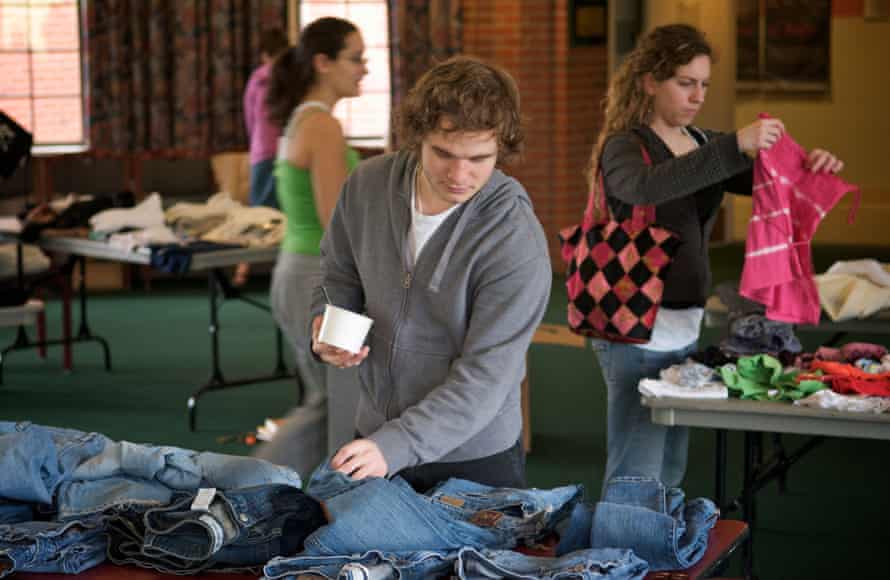Keep Someone From Finding Out High Fashion
It's the toxic relationship as well many of us can't quit. An impulse purchase here, a pick-me-up there. A quick scroll, a flirty click, a casual add-to-basket. Who are nosotros hurting?
Recent news linking the budget fashion giant Boohoo (which also owns Declension, Karen Millen, and at present Oasis and Warehouse) to claims of "mod slavery" in one of Leicester's garment factories has served to remind u.s.a. of the sobering answer to this question. Not only is fashion one of the earth'south nearly wasteful and polluting industries, but it's also i of the most exploitative. Less than 2% of wearable workers globally earn a fair living wage, with most trapped in systemic poverty at most every stage of the long and shadowy supply bondage. While we enjoy the ease, speed and affluence, it's they who are paying the price.
Although that discussion, "enjoy", is debatable, let'south be honest. The past few months have given u.s. pause to have stock, literally in the example of many overflowing wardrobes, and confront our consumerist urges. Exercise high street hauls brand us happy any more? Did they ever? Life on the neverending treadmill of trends is a tiring one, and there's nothing like a pandemic to shift your priorities.
But as lockdown eases how practise we walk abroad? There'southward no one-size-fits-all solution – we're each working with different lifestyles, different tastes and dissimilar levels of privilege. And while some people would have you believe that the but way to dress ethically is to spend £500 on a linen boilersuit and habiliment it every single day, there are plenty of other solutions.
As Paul Simon sang, there must be 50 means to leave your lover. Here are 20 ways to ditch fast fashion for a slower, fairer style.
ane. Have a clearout
This might sound counterintuitive, merely nobody can make the most of their clothes if they have to wade through a bounding main of crumpled polyester each morning. It pays to do a regular audit of everything you have, so you lot know exactly what you need – and what you lot don't. Plus, yous'll find treasures; clothes you've forgotten you have and clothes yous don't (how-do-you-do, mail service-cocktails Zara trip) call back buying. Equally the global campaign grouping Fashion Revolution likes to remind the states, the most sustainable garment is the one already in your wardrobe.
2. Play dress-upwardly
Who says the makeover montage is just for teen romcoms? A good erstwhile-fashioned dressing-up session is one of the best ways to tackle wardrobe ennui, and remind yourself only how many options you take. Near people habiliment 20% of their wardrobe fourscore% of the time, and the waste material charity Wrap says that extending the active lifespan of a garment just past nine months could reduce its carbon, h2o and waste footprints past as much as 30%. And then dedicate an evening to experimenting with different combinations and mastering new styling tricks. Effort dresses over jeans, shirts nether dresses, vests over shirts, scarfs every bit belts. Put a jumper on over that sundress, and congrats! A new skirt.
three. Learn from your mistakes

Go through each detail in your wardrobe and ask: "How many times have I worn this?" If the answer is in single digits, ask why. Interrogate those unloved garms, and be honest. Is it the colour? The shape? The length? A fabric that has you sweating like former lettuce by lunchtime? Did you lot buy it for an invitation that never arrived, or a lifestyle you don't lead? Is it emotional collateral, bought out of insecurity, sadness, hunger or boredom? Learn to place your most common shopping triggers and it becomes and so much easier to resist the lure of the quick-fix purchase.
iv. Wear and echo with pride
Wearing the same outfit to two different parties should not be a revolutionary human action, and yet a Barnardo's study found that 33% of women at present consider clothes "one-time" after wearing them three times. In 2019, Britain shoppers spent an estimated £2.7bn on dress nosotros wore only once. Nosotros have confused dress with dispensable items. Let'southward phase an amnesty and make outfit-repeating a source of celebration, not shame. I similar to think of it as "playing our greatest hits". If Paul McCartney still gets a continuing ovation for Hey Jude, then your iii-year-former wearing apparel deserves a few more nights out.
5. Aim for #30Wears
In the immortal words of Dua Lipa, you need new rules. The #30Wears rule coined by Livia Firth, founder of sustainability consultancy Eco-Historic period, is a benchmark to help yous make savvier choices and give your clothes the lifespan they deserve. Earlier buying anything, ask: will I wearable this at least thirty times? If the respond is no, don't buy.

6. Society, lodge
As Joan Crawford once brash: "Care for your wearing apparel like the adept friends they are." Something'southward gone wrong when buying a new outfit in your lunch hour feels similar an easier set up than trawling through your floordrobe for something that isn't covered in creases, food stains or both. Then have more fourth dimension to organise your clothes, hang them up at the finish of the day (Crawford too condemned wire hangers), and if ironing is your bete noire, consider investing in a handheld steamer. I too swear by storing winter and summer clothes separately, if you lot have infinite. It helps at-home the "new flavor, must shop!" panic and feels exciting every time those old friends reappear.
seven. Become a borrower
If you lot know you're unlikely to wear an particular more than in one case, don't buy information technology – borrow it, whether that's from a generous friend or a fashion rental service such as Hurr, ByRotation, My Wardrobe HQ or Rotaro. Some specialise in statement pieces for special occasions, while others, such equally Onloan and The Devout, run a subscription model that refreshes your wardrobe with trend items for a month at a time. Ideal for the witting commitment-phobe.
eight. Go #Secondhandfirst
If a total ban on shopping is too large a leap, effort this gentler approach. Before buying anything new, effort to observe it secondhand first. This could mean rummaging in a charity or vintage shop, buying a preloved version from a resale platform, or even only borrowing something like from a friend. If we all #chooseused more than often (there's no end to the pithy hashtags), it could reduce the demand for new industry and landfill.
9. Get stitching

The best way to understand how much work goes into 1 garment? Make it yourself. The Keen British Sewing Bee has helped to herald a new generation of home-stitchers over the past few years, while John Lewis and Hobbycraft both reported surges in sewing motorcar sales during lockdown. If you haven't threaded a bobbin since school, I recommend seeking the tutelage of Tilly Walnes, AKA Tilly and the Buttons. Her online guides are friendly and foolproof, while her volume Make It Simple is full of versatile patterns for wardrobe staples, from a one-piece to the perfect white tee.
10. Make new and mend
Even if you lot're never going to start making dresses from scratch, you tin aggrandize your wardrobe horizons with little more a YouTube tutorial and a hotel sewing kit. Apparel are sometimes abandoned for the tiniest of reasons, such equally an awkward neckline or a scratchy label, so don't be agape to get the pair of scissors out. Learn a few basic skills and you can supersede buttons and zips, turn upwardly dragging hems, patch up the worn-out crotch of your best-loved jeans and alter secondhand finds to fit yous perfectly. It doesn't even demand to be cracking – y'all can join the visible mending move, which turns your rips and holes into beautiful design features.
11. Give vintage a chance

Vintage shopping has had a makeover, with a new generation of cool Instagram traders leading the way. While 1970s Laura Ashley is this summer'south hottest holding, anything older than twenty years is considered vintage, which means 90s minimalism and minidresses from 2000 are circling back. Monthly events such every bit @AVirtualVintageMarket round up the very all-time sellers, while the Gem app allows you to sift out the best vintage treasures from beyond the internet – particularly those elusive larger sizes.
12. Rescue the rejects
If you are overnice nearly wearing a stranger's paw-me-downs, deadstock is a sustainable compromise. Ordinarily clothes that were never sold considering of small defects or oversupply, searching "deadstock" on sites such as Etsy and eBay volition return smashing items from across the decades that might have been destined for the bin or incinerator. Likewise, end-of-line dress are an all too common sight in charity shops (yous can spot them by the snipped-out labels). Until the brands stop producing besides much, it's better to give excess stock a loving home.
13. Swap, don't shop

Peer-to-peer rental app Nuw launches a new swapping feature this calendar week, allowing subscribers to list wearing apparel in exchange for virtual credit and utilise information technology to "buy" items from other people. Swopped.co.uk works on the same principle. Or there's always the luddite version: gather a grouping (at a safe social altitude) and trade cast-offs. Warning: seeing your old threads on your most stylish friend may induce regret.
14. Telephone call your amanuensis
The United kingdom has more than 500 wearing apparel agencies – also known as assignment stores – which sell people'due south unwanted clothes, shoes and accessories in commutation for 50% of the profit. Stock is unremarkably in pristine condition and simply a few seasons former, making information technology a groovy mode to save money on premium labels and store the loftier street at 1 remove. Meanwhile, luxury resale sites such every bit Vestiaire Commonage are overflowing with worn-one time nuptials-guest outfits for half the original price. If you purchase new without checking online kickoff, yous're a chump.
15. Just stop shopping
Information technology'southward the cheapest way to downsize your fashion footprint. And yet for many of us, the mere idea of going cold turkey is enough to requite us the shakes. I pledged to buy null brand-new for 2019, and documented the results in my book How to Break Up With Fast Fashion – but if a whole year is too daunting, start smaller. Challenge yourself to three months, or even just ane. It takes time for your brain to suspension the cycle of positive association, and your fingers to stop twitching for the Asos scroll. But later on a few weeks, it gets easier. Promise.
16. Remove temptation

Simply like deleting your ex's number and blocking their Facebook profile, a fast fashion breakup involves admin. So go through your inbox and unsubscribe from all shopping emails – even those from the golfing supplies outlet y'all bought your uncle'southward Christmas present from in 2012. So, fillet your social media feeds. Unfollow all the influencers whose pastel-hued grids be to seduce you lot into buying things, and replace them with boring fashion advocates such as @ajabarber, @venetialamanna, @theniftythrifter_, @enbrogue and @styleand.sustain. Cute infant animate being accounts would work, besides.
17. Store small
If buying new is the simply pick, relax – the roll call of great upstanding fashion brands is expanding. Where utilitarian hemp once ruled all, there's at present fairly made style to conform pretty much every personal style, from slick streetwear to prairie ruffles and maximalist prints. But beware brands that are all oral fissure and no trousers; the best ones should give details of their factories, suppliers and wage commitments online. Kemi Telford, Sika and Mary Benson are among my favourites, while Gather & See does a great job of curating the bunch.
xviii. Practice your homework
As fashion brands cotton on to consumer demand for more upstanding product, it's getting harder to see through the greenwash and piece of work out where we can shop with a clear censor. Luckily, there'south an app for that. Proficient On You has rated more than 2,000 brands on their treatment of people, the planet and animals, providing an at-a-glance verdict from "great" to "avoid". If only Tinder did the aforementioned.
19. Switch to pre-order
Brands such as Olivia Rose, Birdsong and By Megan Crosby prove that patience is a virtue, and made-to-order fashion is the time to come. By only making what customers demand, they tin can minimise waste material and manage their labour more effectively – the antitoxin to fast fashion'south demand for speed. Plus, it's a skillful fashion to examination your own commitment to a trend. If y'all tin't wait a few weeks for that new outfit, maybe it wasn't such a must-have later on all.
20. Ask #WhoMadeMyClothes?
Fashion Revolution's rallying weep since 2013, this simple question tin can exist a powerful weapon in the fight confronting exploitation. If we're e'er going to trust large brands again, we need answers. Where were our apparel made? In which factories? How much were their workers paid, and how much is lining millionaire pockets equally a upshot? Total transparency is the merely look to be wearing this twelvemonth. Metaphorically, at least.
-
How to Break Up With Fast Style by Lauren Bravo (£12.99, Headline) is out now.
0 Response to "Keep Someone From Finding Out High Fashion"
Post a Comment